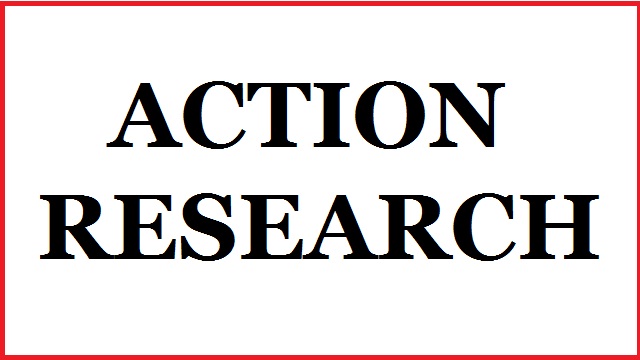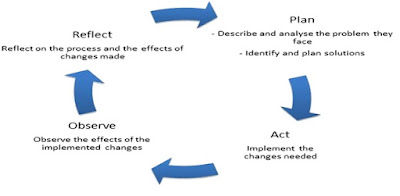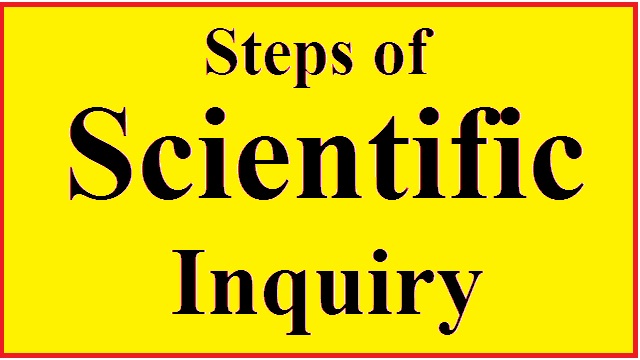ACTION RESEARCH
ACTION RESEARCH
Action Research:
There are two dimensions attached to this word 'action research', Where one is ‘action’ which is doing something and second is ‘research’, which is analyzing. Kurt Lewin, a professor at MIT, first coined the term, "action research'' in 1944. In his1946 paper "Action Research and Minority Problems" he described action research as "a comparative research on the conditions and effects of various forms of social action" that uses "a spiral of steps, each of which is composed of a circle of planning, action and fact-finding about the result of the action".
Action research is “Research in Action-a group of people identify a problem, do something to resolve it, see how successful their efforts were, and if not satisfied, try again.
According to S. M. Corey, “The process by which practitioner attempts to study their problems scientifically in order to guide, correct, evaluate their decisions and action is called Action Research.”
According to J.W.Best - 'Action research is focused on the immediate application not on the development of theory'.
The evolution of an action research agenda within education has been influenced by people such as Kemmis (1983), Ebbutt (1985), Elliott (1991), Hopkins (1985) etc.
Action research in educational study can be defined as ‘systematic inquiry by practitioners (teachers, students, or principals for example) in order to improve teaching and learning process’.
Examples-
1. An Action Research on Absenteeism of Selected Class Students at Bandhgora Kali Krishna Vidyalaya.
2. A Study on Problem of Grammatical Mistake by the Students with Special Reference to Class vi of XYZ Govt. Higher Secondary School".
Characteristics of Action Research:
.
1.It is a process that improves education, in general, by incorporating changes.
2.It is a process involving educators working together to improve their own practice.
3.It is persuasive and authoritative, since it is done by the teacher for the teacher
4.It is collaborative that is, it is composed of educators talking and working with each other educators in empowering relationships.
5.It is participative, since educators are integral members not disinterested outsiders of the research process.
6.It is practical and relevant to classroom teachers since it allows them direct access to research finding.
7.It is developing critical reflection about one's teaching.
8.It is a planned, systematic approach to understanding the learning process..
9.It is critical analysis of educational place of work.
10.It is a cyclical process of planning, acting, developing and reflecting.
11. Qualitative and quantitative method can be employed in conducting an action research.
12. An important feature of action research is its contextual nature. The teacher of a particular school may feel a particular problem but the same problem may not be observed in other schools.
Principles / Components of Action Research:
Borgia and Schuler describe components of action research as the "Five C
1.Commitment: Time commitment should be carefully considered by participants of action research since it takes them time to get acquaintance with other participants, think about change, try new approaches, collect data, interpret results, etc.
2.Collaboration:In an action research all participants are equal to each others in terms of giving ideas, suggestions or anything that leads to success of the change.
3.Concern.-In the research process, participants will build up a group of ‘critical friends’ who trust each other and the value of the project
4.Consideration: As it is mentioned above, reflective practice is a review of a professional research like action research. It demands concentration and careful consideration as one seeks patterns and relationships that will create meaning within the investigation
5.Change: For humans, especially teachers, change is continuing and it is a significant element in remaining their effectiveness
Type of Action Research
From a different point of view, Creswell argues that there are two main types of action research as follows:
1.Practical Action Research : Practical action research is used in situations in which teacher researchers ‘seek to enhance the practice of education through the systematic study of a local problem." It usually involves a small case research project, narrowly directs at a specific problem or issue and is undertaken by individual teachers or teams within a particular education setting.
2.Participatory Action Research: Participatory action research is usually implemented in larger scale to improve the quality of people's organization, communities and family lives”. Namely, it has a social and community orientation and it focuses on research that contributes to emancipation or change in our society".
Areas of Action Research
The areas of action research can falls under the following categories
1.Related to learner: it can be motivation, learning style, concentration etc.
2. Related to teachers: it can be on levels of competencies, teaching style, attitude towards week student, motivation etc.
3. Related to methodology: it can be on activity based teaching, child centered learning, Play Way approach, project approach etc.
4. Related to evaluation: it can be on criterion reference test, Diagnostic testing, formative testing etc.
5. Related to curriculum: it can be on mechanism of Curriculum design, teacher's role in curriculum design and development etc.
Steps of Action Research
Nunandevelops seven steps in the action research cycle:
Step 1: Initiation - A problem triggers the idea of action research.
Step 2: Preliminary investigation - Baseline data are collected to help understand the nature of the problem.
Step 3: Hypotheses - A hypothesis is formulated after reviewing the initial data.
Step 4: Intervention - A number of strategies are devised and applied.
Step 5: Evaluation - An assessment is carried out to evaluate the intervention. Some steps may be repeated.
Step 6: Dissemination - A report of the research is published. Ideas emerged from the research are shared.
Step 7: Follow-up – Alternative solutions for the problem are continually investigated.
Gay and Airasias propose the basic steps in action research as follows:
Step 1: Identify topic or issue to study,
Step 2: Collect data related to the chosen topic or issue
Step 3: Analyze and interpreted the collected data and
Step 4: Carry out action planning, which represents the application of the action research results,
In contrast, Creswell looks at procedure of action research as detail process with 8 steps as:
Step 1: Determine if action research is the best design to use
Step 2: Identity a problem to study
Step 3: Locate resources to help address the problem
Step 4: Identity information to be needed;
Step 5: Implement the data collection
Step 6: Analyze the data,
Step 7: Develop a plan for action and
Step 8: Implement the plan and reflect.
Stephen Kammis developed this model, it has four steps--

In brief, these above processes of action research are different from one another since they are basic, simple or elaborate models. During the research, one may find models either more effective or less suitable than the other ones depending on particular situations and education settings.
Importance of Action Research:
1. Action research provides educators with opportunities to better understand and therefore improve their educational practices.
2. Action research provide educators with alternative ways of viewing and approaching educational questions and problems with new ways of exam meaning on educational practices.
3. To re-construct our own knowledge through action and for action in real situations.
4. To provide new opportunities to teachers and teacher educators to reflect and to evaluate their own professional practices.
5. To explore newer ideas, methods, approaches, materials, strategies etc.
6. To make educational practices more meaningful.
Limitations of Action Research
1. Lack of Time
Action Research is demanding of space and time, both of which are stretched to their limits. o
2. Validity
Inevitable research bias
3.Results are not Generalizable
4.less emphasize on the previous findings or literature review.
5.Teachers may not be able to do research as professional researchers.
6. It may not contribute significantly to the fund of knowledge .
7.It may/may not use standardized tools
8.It's field is generally narrow..
Conclusion:Action research is an important area for the teachers. It is seen as a significant tool to empower the teacher and also act as the tool for the reflection for his or her own practices. The action research is a systematic process involving various steps from the identification of the problem to the conclusions and decision making.
References
1.Best, J.W., & Kahn, J.V. (1998). Research in education (8th ed.).
2.Borg, W. (1981). Applying educational research: A practical guide for teachers.New York:Longman.
3.Brennan, M., & Williamson, P. (1981). Investigating learning in schools. Victoria,Australia: Deakin University Press.
4.https://www.sagepub.com/sites/default/files/upm-binaries/36584_01_Koshy_et_al_Ch_01.pdf.
5. https://journals.sagepub.com/home/arj.
6. https://www.thecreativeeducator.com/v07/articles/Embracing_Action_Research.





Comments
Post a Comment